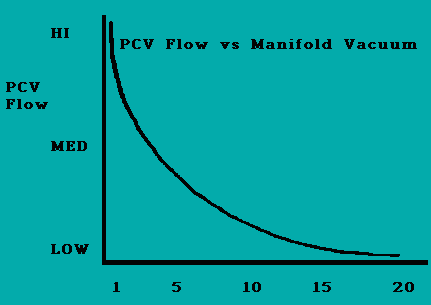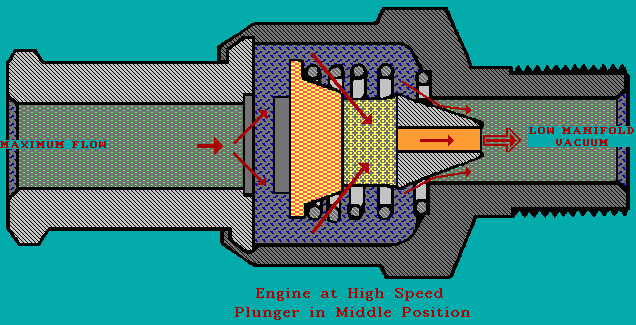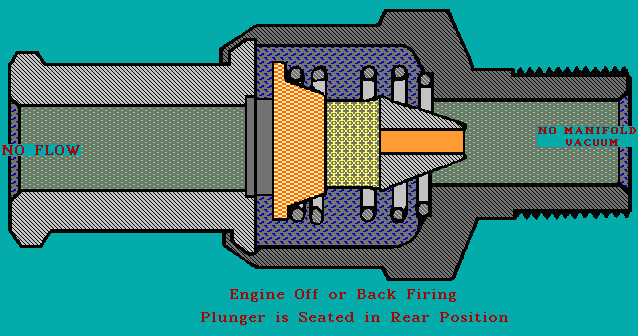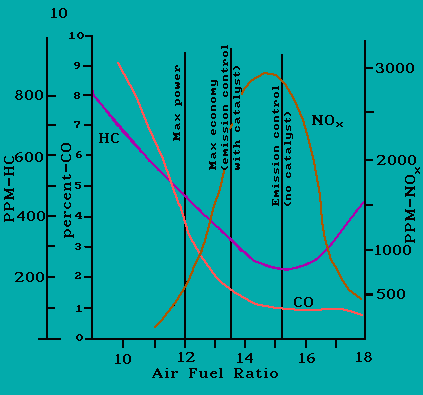EMISSIONS CONTROLS:
"ALPHABET SOUP" AND FUEL ECONOMY
- GOAL:
- To inform students of the types and purpose of common emission control systems and how these systems could impact fuel economy.
- OBJECTIVES:
- The students will learn:
- 1. The function of the most common emissions control systems and the meaning of their acronyms.
- 2. The impact of common malfunctioning emissions controls systems on fuel economy.
- LESSON/INFORMATION:
- P.C.V. Valve
- Emissions controls were first installed on passenger cars and light trucks in 1962. This first emission control, the P.C.V. valve, is still used on present production vehicles. The acronym P.C.V. stands for Positive Crankcase Ventilation. The valve of this system regulates the flow rate of crankcase blow-by gases into the intake manifold, thus burning these gases again. These gases contain large quantities of unburned hydro-carbons and some carbon monoxide. Flow rate through the valve is inverse to intake manifold vacuum. The higher the vacuum (i.e., at idle and low cruise speeds) the lower the flow rate. At wide open throttle when crankcase blow-by pressure is greatest the P.C.V. flows at the maximum rate (See Figures 1, 1a, 1b, and 1c ). A malfunctioning P.C.V. may result in a hard starting engine, surge at cruise, and hesitation on acceleration. P.C.V. malfunctions lower fuel economy since it is a vacuum device.

Figure 1

Figure 1a

Figure 1b

Figure 1c
- Excessively lean mixtures must be compensated with extra fuel. The air and this added fuel mix poorly and generate little real power. Lower mpg results.
- E.F.E. Control
- To make fuel vaporize during cold engine operation, an Early Fuel Evaporation (E.F.E.) system is necessary. This system directs heat to the base of the intake manifold, carburetor, or central fuel injection system. Heat gain results from exhaust gases being routed to a closed passage or by electrically heating a grid installed in the air / fuel passage. The transferred heat helps vaporize the fuel resulting in a more efficient fuel mixture. The more efficient mixture increases cold engine performance and decreases unburned hydrocarbons and carbon monoxide. Also, there is an increase in fuel economy. The control could vary from a simple switch, as in the case of the electric type, to a series of vacuum lines and a control valve. A malfunctioning E.F.E. control negatively impacts driveability, emissions, and fuel economy. An E.F.E. system may also negatively impact these three if the system fails to "turn off" after an engine reaches operating temperature. Once the engine achieves operating temperature, an additional increase in fuel temperature results in fuel overheating. This could result in decreased driveability, increased emissions, and reduced fuel economy. Excessively heated liquid fuel expands beyond its ability to burn efficiently - an over leaning condition. As a result of this excessive leaning condition, the Exhaust Gas Oxygen (E.G.O.) sensor of a computer controlled closed-loop system signals the computer of that condition, and results in fuel enrichment and timing retardation. The most important effect is decreased fuel economy.
- E.G.R. Value
- The Exhaust Gas Recirculation (E.G.R.) valve is the heart of the E.G.R. system. This system reduces oxides of nitrogen (NOx). NOx is formed when engine combustion temperatures rise as a result of leaning out the air to fuel mixture. Fuel leaning is necessary to accomplish reduced unburned hydrocarbons (HC) and carbon monoxide (CO). In an uncontrolled engine, reduced HC and CO results in increasing NOx (See Figure 2). Maximum leaning occurs under cruise conditions. During this mode, small amounts of exhaust gases are metered into the intake manifold below the carburetor, central fuel injector, or multipoint injection throttle plate. Introduction of exhaust gases into the air-fuel mixture quenches the combustion process to below the critical oxygen-nitrogen bonding temperature.

Figure 2
- Quenching results since exhaust gases are inert and are relatively cold as compared to peak stoichioemetric (the chemically ideal mixture of the fuel and air) combustion chamber temperatures.
- E.G.R. valves vary from the simple vacuum-mechanical type to a more complex computer assisted transducerized vacuum-mechanical type. All types meter exhaust flow rates into the intake manifold by using a tapered metering pod or pintle.
- E.G.R. is not necessary during cold engine operation, during deceleration or acceleration, or at idle. Thermal sensors inhibit operation of this control during cold engine operation. Regulated vacuum controls the movement of the pintle (the long, tapered movable portion of the valve. Thus, exhaust flow rate is proportioned as a function of engine load and speed. A spring or a computer controlled solenoid closes the E.G.R. valve during deceleration, acceleration or at idle. Because the E.G.R. system only operates at cruise speeds, fuel economy is not negatively affected unless the system malfunctions.
- Typical malfunctions include failure to close during deceleration or acceleration, at idle, and operation when the engine is cold. Since exhaust gases quench the mixture, a malfunctioning valve will produce a hesitation and power lag during acceleration. The driver will respond by increasing input to the accelerator, thus increasing fuel flow and decreasing fuel economy. If the E.G.R. valve fails to completely close at idle, the engine will idle roughly as if there is a vacuum leak. In older carbureted vehicles, technicians may adjust the mixture to compensate for this abnormally lean mixture condition. On computer controlled engines, sensors may enrich the mixture to compensate for the abnormal condition. Again, the result is wasted fuel.
- E.G.R. valves require periodic servicing to remove exhaust deposits from the pintle, seat and passages. The opening and closing operation of the valve as well as the soundness of the vacuum lines and connections should also be checked during E.G.R. servicing. Most manufacturers recommend E.G.R. service every 30,000 to 50,000 miles.
- E.G.O. Sensor
- Computer controlled vehicles use a device in the exhaust stream referred to as an Exhaust Gas Oxygen (E.G.O.) sensor. This device "reads" the amount of oxygen in the exhaust gases and transmits this information to the on-board engine computer. The computer uses E.G.O. data as a factor in regulating fuel flow and adjusting timing. An E.G.O. sensor does not function until some prescribed minimum operating temperature. When exhaust gases are below that prescribed temperature, the engine operates in open loop. The engine operates in closed loop when the E.G.O. reaches prescribed temperatures.
- When in closed loop, the E.G.O. reads the exhaust gas oxygen (O2) content. If the O2 content is too low, then the computer "leans" the fuel mixture and/or advances the timing. Conversely, if the E.G.O. reads too much O2, then the computer enriches the fuel mixture and/or retards the timing.
- E.G.O. sensors tend to be very reliable. Some manufacturers recommend replacement every 60,000 miles. Others recommend periodic functional checks. E.G.O. sensors can give false lean signals resulting in decreased mpg. A slightly leaking exhaust system gasket between the head and the E.G.O. can add O2 to the exhaust stream. Since this O2 did not come from the combustion cycle, a false "lean" condition will be signaled to the computer. If the air pump management system fails to fully close air delivery ahead of the E.G.O. once in closed loop, the E.G.O. will false signal a lean condition. Any lean condition is corrected by adding fuel and/or reducing timing. Either or both will result in reduced mpg.
- ACTIVITY:
- Compare two different makes and models, light duty (passenger car, light truck, or van) vehicles. Use the chart provided to record data. For each vehicle:
- 1. Determine the recommended maintenance intervals for the PCV, EFE, EGR and EGO from the driver's manual or maintenance manual.
- 2. Determine the correct procedures to functionally check the PCV, EFE, EGR, and EGO from an appropriate shop manual.
- 3. Perform these functional checks on the PCV, EFE, EGR, and EGO.
- 4. Review your findings from these functional checks with your instructor.
- 5. If required and approved by the instructor, perform any needed service operations to return the PCV, EFE, EGR, and EGO to full operation.
- 6. Summarize the findings.
- RECOMMENDED MAINTENANCE INTERVALS MONTHS/MILES
- Vehicle #1
- PCV ______________________
- EFE ______________________
- EGR ______________________
- EGO ______________________
- Vehicle #2
- PCV ______________________
- EFE ______________________
- EGR ______________________
- EGO ______________________
- BRIEFLY SUMMARIZE FUNCTIONAL TEST PROCEDURE
- Vehicle #1
- PCV ______________________
- EFE ______________________
- EGR ______________________
- EGO ______________________
- Vehicle #2
- PCV ______________________
- EFE ______________________
- EGR ______________________
- EGO ______________________
- FUNCTIONAL TEST
- (Circle Pass or Fail)
- Vehicle #1
- PCV ___Pass___Fail
- EFE ___Pass___Fail
- EGR ___Pass___Fail
- EGO ___Pass___Fail
- Vehicle #2
- PCV ___Pass___Fail
- EFE ___Pass___Fail
- EGR ___Pass___Fail
- EGO ___Pass___Fail
- Instructor Review:
- Comments - Vehicle #1: _________________________________________________
- ______________________________________________________________________
- ______________________________________________________________________
- Comments - Vehicle #2: __________________________________________________
- ______________________________________________________________________
- ______________________________________________________________________
- Repairs Made:
- Vehicle #1:
- ___________________________________________________________________________
- ___________________________________________________________________________
- ___________________________________________________________________________
- Vehicle #2
- ___________________________________________________________________________
- ___________________________________________________________________________
- ___________________________________________________________________________
- Summary:
- Vehicle #1:
- ___________________________________________________________________________
- ___________________________________________________________________________
- ___________________________________________________________________________
- Vehicle #2
- ___________________________________________________________________________
- ___________________________________________________________________________
- ___________________________________________________________________________
- INFORMATION CHECK:
- PART 1:
- Directions: Indicate whether the statements below are true or false. If the statement is false, explain why it is false.
- 1. _______ A properly operating EGR value should not function during cold engine operation.
- 2. _______ At wide open throttle, the PCV should be closed, limiting flow to a minimum.
- 3. _______ An EGO sensor functions in both closed and open loop.
- 4. _______ High exhaust-oxygen levels always indicates an excessively lean condition.
- 5. _______ EFE systems should operate during cold engine modes.
- PART 2: Write what each acronym stands for:
- A.) E.G.O. __________________________________________
- B.) E.F.E. __________________________________________
- C.) E.G.R. __________________________________________
- D.) P.C.V. __________________________________________
- TEACHER'S NOTES:
- Students frequently use acronyms freely without fully understanding what each letter represents. This guide should help students correlate these acronyms with the purpose, function, or test, and probable malfunction for each of the four. By having students complete this exercise for two different vehicles, comparisons may be drawn. It could be beneficial to get students to perform these checks on at least one model from popular makes (i.e., GM, Ford, Chrysler, Toyota, Nissan, and Honda). Make sure students select models from different manufacturers (i.e., GM and Toyota). Carefully review student responses since many imported and late model domestic models use widely diverse systems.
- ANSWERS TO INFORMATION CHECK:
- Part 1:
- 1. True.
- 2. False. Wide-open throttle requires maximum flow. Vacuum approaches zero, thus, the valve fully opens.
- 3. False. EGO's function only in closed loop.
- 4. False. Abnormally high O2 levels could result from a malfunctioning air management system or leaking exhaust system.
- 5. True.
- Part 2:
- A. Exhaust Gas Oxygen (Sensor)
- B. Early Fuel Evaporator (Sensor)
- C. Exhaust Gas Recirculation (Valve)
- D. Positive Crankcase Ventilation (Valve)
- REFERENCES:
- Ellinger, Hebert. Automechanics, 4th Edition. Prentice Hall, Englewood Cliffs, NJ. 1988.
Comments or questions to: TechAsmt@LA.GOV
Return to Automotive Menu








